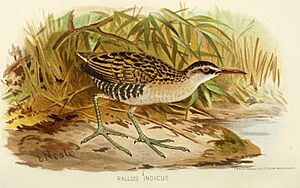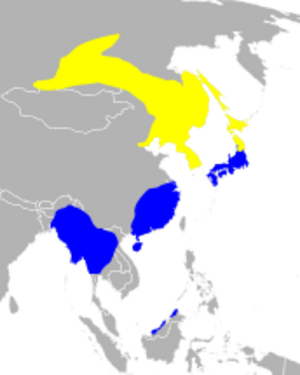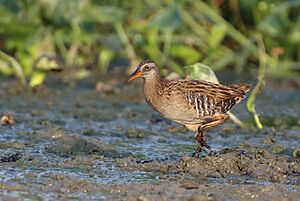Brown-cheeked rail facts for kids
Quick facts for kids Brown-cheeked railTemporal range: Pleistocene to Recent, 534,000 - 0.00 years ago
|
|
|---|---|
 |
|
| Conservation status | |
| Scientific classification | |
| Genus: |
Rallus
|
| Species: |
indicus
|
 |
|
|
Breeding summer visitor
(ranges are approximate)Resident year-round Winter visitor |
|
The brown-cheeked rail or eastern water rail (Rallus indicus) is a type of bird in the Rallidae family. It's a shy bird that often hides in wet, marshy places. This bird breeds in northern Mongolia, eastern Siberia, northeast China, Korea, and northern Japan. When winter arrives, it flies south to warmer areas in Southeast Asia. For a long time, scientists thought it was just a subspecies of the water rail. Now, it is known as its own unique species.
What Makes This Bird Special?

The brown-cheeked rail looks a bit different from its close relative, the water rail. Its upper feathers are lighter, and its belly has a brownish tint. It also has a clear brown stripe that goes right through its eye.
One of the biggest differences is its voice! The brown-cheeked rail makes very distinct sounds. Its courtship call, which it makes all year, is a sharp, clear kyu sound. Its song is a series of metallic shrink, shrink notes, repeated quickly. These calls are quite different from those of the water rail.
How Scientists Learned About It
Early bird experts, like those who wrote The Fauna of British India in 1898, first thought it was a separate species. Later, in 1929, another expert decided it was just a subspecies.
However, in 2005, a bird expert named Pamela C. Rasmussen studied Asian birds closely. She noticed the brown-cheeked rail's unique calls and decided it should be a full species again. She even renamed the other water rail types as the western water rail. Many other bird experts now agree with her.
A study in 2010 looked at the bird's DNA. This study showed that the brown-cheeked rail likely separated from the western water rail about 534,000 years ago. This genetic evidence further supported the idea that it is its own species.
Where Do Brown-Cheeked Rails Live?
These birds are mostly migratory, meaning they travel long distances. They spend their winters in southern Japan, eastern China, and northern Borneo. You can also find them in parts of Bangladesh, Burma, Laos, and Thailand during winter. They usually don't go much further south in mainland Southeast Asia.
Sometimes, exhausted rails are found in India after their long journey. The birds that breed on the Japanese island of Hokkaido mostly fly south for winter, often to Korea. However, a few stay in the coastal marshes of Honshu during the colder months.


